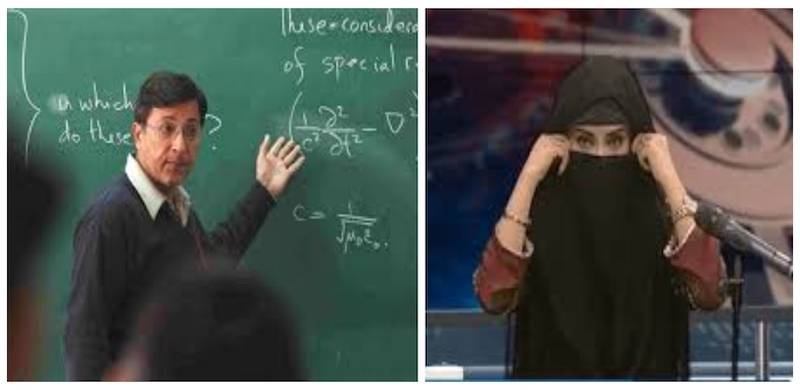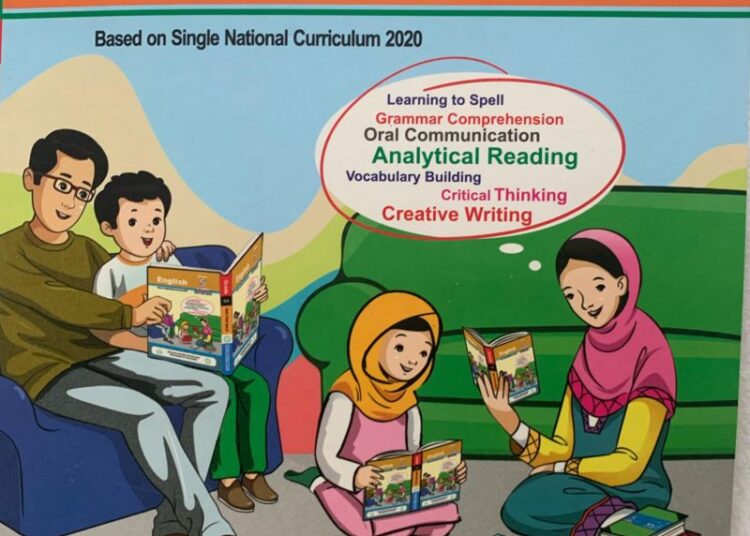
The stereotypical portrayal of women in Single National Curriculum (SNC) model books has led to a controversy and concerns have been raised by parents and educationists alike. Textual and visual content of model books prepared under the SNC guidelines is being heavily criticised by activists and commentators on social media who are of the opinion that the new system is more regressive than the existing curriculum.
The government’s education policy is already marred by severe shortcomings and there remains deeply rooted education inequity, not least because more than 20 million children aged 5-16 are out of school. The structural issues ranging from teacher training to enrolment remain a cause for concern.
Across SNC books, many school going girls and women adults have been shown wearing Hijab. Gender analysis has revealed that women dressing has reinforced previously held gender stereotypes while male figures have been portrayed diversely. Moreover, women have been mainly represented in roles traditionally associated with females for e.g. teacher, nurse and housewife.

Criticising the dress code for women outlined in the SNC books, Dr. Pervez Hoodboy labelled the new system a ‘sham’ during a talk show. Dr. Hoodbhoy lambasted the concept of Hijab/burka for school going and university students and said that burka-clad students in his classrooms would not ask questions. He explained that enforcing burka at such an early age is tantamount to shattering confidence and critical thinking. Dr Hoodbhoy’s remarks have generated a debate on whether Hijab/burka counteracts questioning and analysis in classroom environments.
The argument has been refuted by both conservatives as well as some liberals. Anchor Meher Bokhari argued that the mere act of wearing Hijab and burka does not diminish confidence.
However, a closer look at Hoodbhoy’s arguments tells us that it is broader in scope. Those criticising Hoodbhoy argue that many position holders in board examinations in Pakistan are hijab/burka observing women. What these critics don't understand is that local examination boards, including Matric, reward rote learning and conformity. The process of obtaining marks is premised upon rattafication: mindless memorisation of facts and figures. Hence, Hijab clad women who’ve secured top marks are not an indication of critically minded or question oriented individuals, as Hoodbhoy's critics suggest.
In fact, burka tends to erase the women's identity. Hoodbhoy's argument that women who are forced to wear burka lack confidence because they are unable to express themselves freely holds weight because of the erasure of identity that comes with wearing a burka. The constant reminder that the burka/hijab is centripetal to their freedom and movement instils powerlessness, especially for those who are uncomfortable wearing it and are forced into it.
Religion aside, there is vast amount of literature and research outlining the negative and positive effects of Hijab on self esteem, confidence and emancipation in classroom settings and beyond. It is in light of these effects that Hoodbhoy’s comments require assessment by conservative and woke twitter. As someone who has taught in Pakistan's educational institutions for years, Hoodbhoy's opinion certainly matters.
Moreover, conservative domination of educational institutes has seen a remarkable uptick in recent years -- which indicates that our education system is failing to produce enlightened individuals. The Punjab University campus, which constitutes students from diverse backgrounds, has witnessed innumerable cases of moral policing by male students vying for physical separation between opposite sexes. In many universities, women have been either told to don the Hijab, wear a dupatta or face punitive measures by administration.
Depicting and portraying women in stereotypical dressing in the SNC accentuates the process of dress policing women in society at large face. The consistent pictorial representation of women abiding by a certain dress code or sitting at an arm’s length from male colleagues will aid the moral and dress policing of women in future generations.
A similar argument was made by Dr. Ayesha Razzaque during the same show. In essence, SNC not only feeds off of conservative societal beliefs but consolidates them for future generations.
All things considered, one is left to ponder about the enforcement of the SNC. Across all provinces, every single book published along SNC guidelines needs an approval certificate from an Ulema board. This approval requirement extends beyond Islamiat to Science, Math, Pakistan Studies and even English books.
Perhaps, the agenda of the SNC was set in line with the expectations designed and held dearly by the conservative sections of our society, which dominate the government and power corridors. It is their bidding that the SNC is doing rather than uplifting the educational standards.
The government’s education policy is already marred by severe shortcomings and there remains deeply rooted education inequity, not least because more than 20 million children aged 5-16 are out of school. The structural issues ranging from teacher training to enrolment remain a cause for concern.
Across SNC books, many school going girls and women adults have been shown wearing Hijab. Gender analysis has revealed that women dressing has reinforced previously held gender stereotypes while male figures have been portrayed diversely. Moreover, women have been mainly represented in roles traditionally associated with females for e.g. teacher, nurse and housewife.

Criticising the dress code for women outlined in the SNC books, Dr. Pervez Hoodboy labelled the new system a ‘sham’ during a talk show. Dr. Hoodbhoy lambasted the concept of Hijab/burka for school going and university students and said that burka-clad students in his classrooms would not ask questions. He explained that enforcing burka at such an early age is tantamount to shattering confidence and critical thinking. Dr Hoodbhoy’s remarks have generated a debate on whether Hijab/burka counteracts questioning and analysis in classroom environments.
Gender analysis has revealed that women dressing has reinforced previously held gender stereotypes while male figures have been portrayed diversely.
The argument has been refuted by both conservatives as well as some liberals. Anchor Meher Bokhari argued that the mere act of wearing Hijab and burka does not diminish confidence.
However, a closer look at Hoodbhoy’s arguments tells us that it is broader in scope. Those criticising Hoodbhoy argue that many position holders in board examinations in Pakistan are hijab/burka observing women. What these critics don't understand is that local examination boards, including Matric, reward rote learning and conformity. The process of obtaining marks is premised upon rattafication: mindless memorisation of facts and figures. Hence, Hijab clad women who’ve secured top marks are not an indication of critically minded or question oriented individuals, as Hoodbhoy's critics suggest.
In fact, burka tends to erase the women's identity. Hoodbhoy's argument that women who are forced to wear burka lack confidence because they are unable to express themselves freely holds weight because of the erasure of identity that comes with wearing a burka. The constant reminder that the burka/hijab is centripetal to their freedom and movement instils powerlessness, especially for those who are uncomfortable wearing it and are forced into it.
Religion aside, there is vast amount of literature and research outlining the negative and positive effects of Hijab on self esteem, confidence and emancipation in classroom settings and beyond. It is in light of these effects that Hoodbhoy’s comments require assessment by conservative and woke twitter. As someone who has taught in Pakistan's educational institutions for years, Hoodbhoy's opinion certainly matters.
Moreover, conservative domination of educational institutes has seen a remarkable uptick in recent years -- which indicates that our education system is failing to produce enlightened individuals. The Punjab University campus, which constitutes students from diverse backgrounds, has witnessed innumerable cases of moral policing by male students vying for physical separation between opposite sexes. In many universities, women have been either told to don the Hijab, wear a dupatta or face punitive measures by administration.
Religion aside, there is vast amount of literature and research outlining the negative and positive effects of Hijab on self esteem, confidence and emancipation in classroom settings and beyond.
Depicting and portraying women in stereotypical dressing in the SNC accentuates the process of dress policing women in society at large face. The consistent pictorial representation of women abiding by a certain dress code or sitting at an arm’s length from male colleagues will aid the moral and dress policing of women in future generations.
A similar argument was made by Dr. Ayesha Razzaque during the same show. In essence, SNC not only feeds off of conservative societal beliefs but consolidates them for future generations.
All things considered, one is left to ponder about the enforcement of the SNC. Across all provinces, every single book published along SNC guidelines needs an approval certificate from an Ulema board. This approval requirement extends beyond Islamiat to Science, Math, Pakistan Studies and even English books.
Perhaps, the agenda of the SNC was set in line with the expectations designed and held dearly by the conservative sections of our society, which dominate the government and power corridors. It is their bidding that the SNC is doing rather than uplifting the educational standards.

